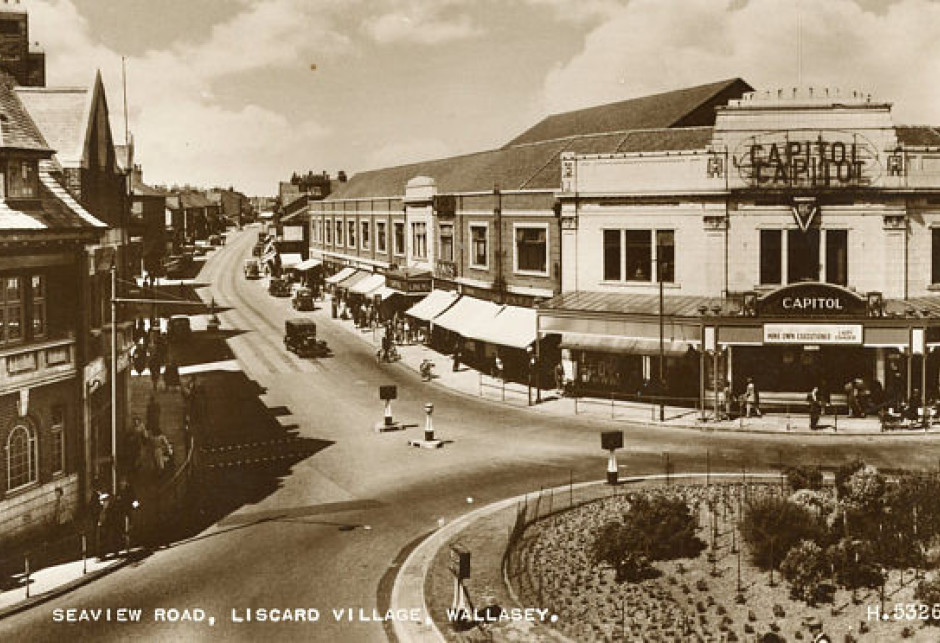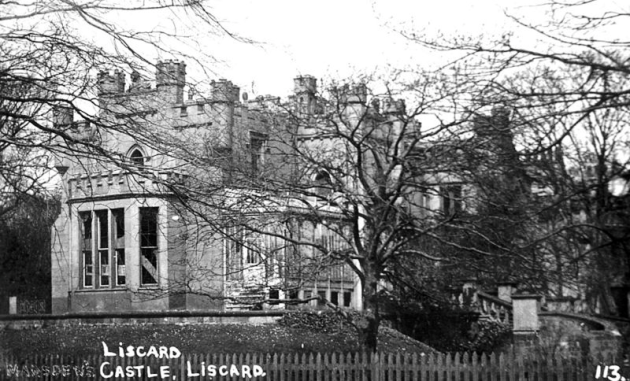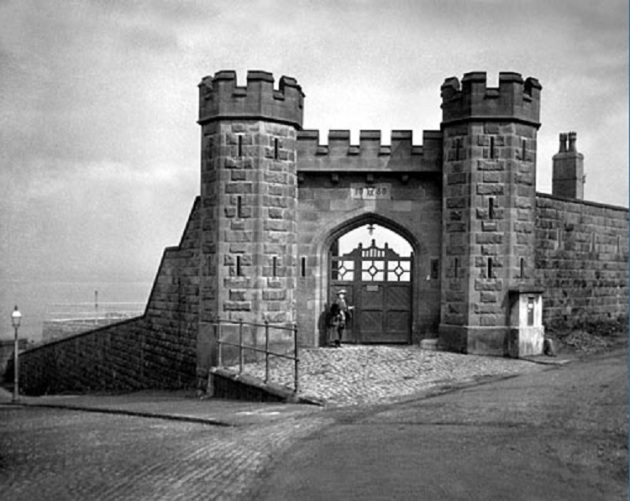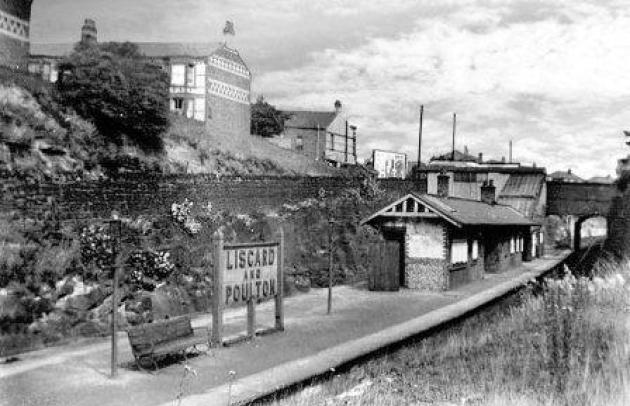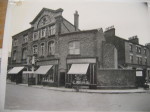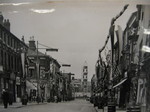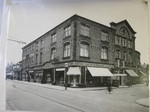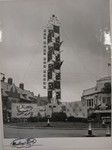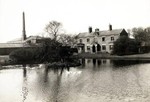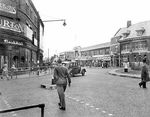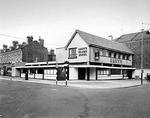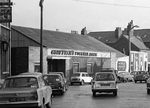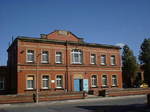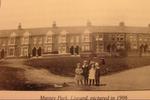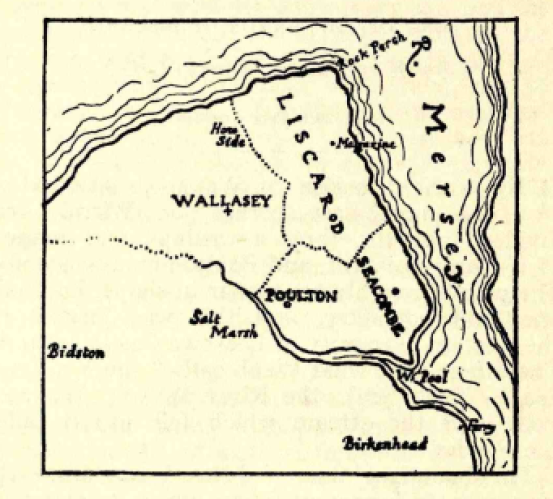Liscard, Wallasey
Liscard Hall was built in 1835 by a Liverpool merchant, Sir John Tobin. Its grounds later became Central Park, and the building itself later became an art college. A “model farm” was also developed nearby by his family. The former Grade II listed arts building within the grounds of Central Park was destroyed by fire on 7 July 2008, and has been completely demolished.
Sir John Tobin (1763-1851), 'merchant', born Isle of Man, 'by the 1790s was a master, operating in the slave trade between Africa and the Caribbean', and operated as a privateer in the early years of the war with France. Married 1798 Sarah Aspinall (1770-1853), daughter of James Aspinall (1729-1787), a prominent Liverpool slave-trader. 'This marriage may have brought him capital'. Pioneer of legitimate palm oil trade. Knighted 1820. Built Liscard Hall 1835. Made his fortune from the slave trade appears as Captain in 6 slaving voyages 1793-1803 and as part owner in 10 slaving voyages 1794-1804.
Another large house in the district was Liscard Castle, it took on the appearance of a castle with its battlements and stone lion embellishments. It was built around 1841 and was demolished in 1902. The locals referred to the structure as Marsden Folly.
The original owner a Mr John Marsden had made his fortune from the manufacture of brushes across the water in Liverpool.
Liscard Battery was built in 1858 to help protect shipping on the River Mersey and defend the port of Liverpool. It was equipped with seven 10-inch guns. Set back from the river and hidden by new building, it was known as "the snake in the grass" to local inhabitants. The battery was obsolete by 1912, and sold on, and houses were erected on top, and now the site has an odd appearance with only the curtain wall and ornate crenellated gatehouse surviving to this day.
The area originally had a railway station as part of the Wirral Railway. Known as Liscard and Poulton railway station, it was part of a branch line which included Seacombe railway station as its terminus. This branch is long-closed and its route now forms the approach to the Kingsway Tunnel.
THE JOURNAL OF JOHN HOUGH, LORD OF THE MANOR OF LiSCARD. By E. Cuthbert Woods, L.D.S. Read 26th February 1920.
THE ancient parish of Wallasey, situated at the north-east corner of Wirral, was divided into the three townships and manors of
Wallasey, Liscard, and Poulton-cum-Seacombe.
The parish, roughly triangular in shape, had only one land boundary, and this was formed by the western extremity of Leasowe Castle grounds. The others were what Webb calls " the Vergivian Sea "
[Irish Sea], the River Mersey, Wallasey Pool, and the stream which fell into it called the Fender. The boundary line of Liscard ran from the Mersey, near Egremont Ferry, up to a point near the top of
Church Street, then across what is now the Central Park, to the water tower in Mill Lane, on past the Boot Inn, to Hoes Side, and over Stone Bark Hill to the sea ; dividing Wallasey on the west from
Liscard on the east. From the water tower, another line followed nearly the course of Mill Lane, down to the Pool, and separated Wallasey on the north from Poulton- cum-Seacombe on the
south.Several derivations of the name Liscard have been suggested. The most
ancient forms of the word are found in Aston charters now in the British Museum Lisnekarke (early Henry III.), Lisnecaric (late Henry III.) and Lisecarck
(Edward I.)
The popular derivation refers it to a Lees-Kirk, the existence of which Robinson refers to in 1729.' It is supposed to have stood near the site of Earlston Road
Library, but on the other side of the road close to an old house built by one of the Molyneux family of Wallasey in 1829 and named Kirk Cottage.
Mr. W. F. Irvine suggests that the first part of the name may be the Gadhelic word lis, an earthen fort, and refers to Liskeard in Cornwall as a possible parallel.
Mr. Henry Harrison, in noticing these, puts forward another derivation, from Us and ceard, meaning "the enclosure of the smith."
It is unfortunate that the Aston deeds were not accessible when he wrote, as they show that the forms Lisnecark and Liscark are the more ancient, and suggest " the
enclosure on the Rock " as the meaning of the name. The " Rock light " is there now. " Liscard " appears as early as 1350. The history of the manor is very obscure, there is little
evidence.
In 1086 Robert of Rhuddlan held the whole of Wallasey; it was assessed as hide of land, and there was land for 4 ploughs. A Frenchman had a plough there, with two oxherds, a radman and a bordar or
cottager. It is tempting to suppose that this Frenchman's estate was Liscard and that its fourfold division in later times sprang from the four tenants named. Liscard was at any rate distinct from
the main part of Wallasey at an early date, for when Robert of Rhuddlan died without heirs and his lands were regranted by the earl, Liscard went entirely to the lord of Halton, but only a moiety of
the rest of Wallasey, the other moiety being held of the earl in chief. In the time of Edward II. the manor of Liscard was held by the Astons of Aston under the barony of Halton by doing the service
due from the fifth part of a knight's fee. The family continued to hold it until the end of the sixteenth century, but the amount of service due varies in the recorded inquisitions. The origin of
their title is unknown ; it may have come from a direct grant from the lord of Halton, but more probably by marriage with an heiress.
Wheatland House, which till about 1902 stood in Wheatland Lane, Seacombe, bore the date 1684 and the initials PWM, and was in all probability built by Philip Wilson, who married Margaret Meoles.
The Thomas Meoles who married Mary Bristow was an ironmonger in the city of Chester and died in 1693. John Hough, who succeeded as lord of the manor in 1752, married Margery Litherland, a widow with two children, Bethia and Catherine ; the latter died in childhood, and Bethia married John Audley and George Forshall.
In 1744 Margery Hough died, and was buried at Wallasey on 11 June. John Hough lived in a stone house (pulled down about sixty years ago) which stood back from Liscard Road, from which it was separated by a long garden, and just to the south of West- minster Road. The well which supplied his requirements was still in use after the house was demolished. He died in 1797, and was buried on the south side of the old church at Wallasey on 18 June.
As he had no issue, he left his estate in the care of four trustees and executors, Rev. Geo. Briggs, Edward Newton, John Webster, and Matthew Taylor. The lordship and
manor of Liscard, with the rights, members and appurtenances thereunto belonging, and the hereditaments, etc., were advertised for sale .by public auction on 20 August, 1800, at Seacombe Boat House, when and where several persons attended to
bid for the same, none of whom offered what was thought the value. The indentures of 2 and 3 Feb., 1801, go on to inform us
that:
Abstract of Title of Lands belonging to AtheJohn Penkett, merchant, must have been a well-known figure on 'Change in Liverpool for many years.
He was agent to the gunpowder magazines, Liscard a very important position, when every ship which left the port was armed and had an office in Tarleton Buildings, Chapel Street. His residence, according to the 1810 (Gore) Directory, was at 95 Duke Street, but he evidently had a house in Liscard earlier than this, for in a lease of 17 and 18 Jan., 1794, he is referred to as of " Sea Bank within Liscard."
It is to the kindness of Mr. T. D. M. Crawley, a great-grandson of his, that I have had access to the deeds of Liscard Manor, among which is the journal which John Hough kept from 1774 to 1790. The Old Liscard Manor House is shown on the site of Earlston Library in Kaye's map of 1844 and Poore's of 1859.
A house called Rose Mount is shown in Philip's map as occupying the site about 1868. What is now known as the Manor House, near the Home for Aged Mariners, first appears with this name in Gore's Liverpool Directory for 1847. Up to this period, in both directories and maps, it had been called "Sea Bank." There is no dated stone or water head on the Manor House, but there is a bell on one of the outbuildings in the courtyard with the date 1790 upon it. A house on the Promenade at the corner of Caithness Drive, which was originally two cottages, bears on the back the initials and date " J. P." and 1806. In the cellar at the Manor House is an iron ring in the wall, used to fasten prisoners to. Mortimer1 says that previous to 1843 " much inconvenience had long been experienced from the want of a lock-up, or prison, there being none nearer than Birkenhead, a distance from some parts of the parish of five or six miles, and prisoners were frequently confined in the houses of the constables, or even in the houses of the justices until their final commitment." Eyes, in his survey of 1828, says :
The late John Penkett, esq., claimed to be lord of the manor or reputed manor, and in the division of the common lands this claim was admitted, and a portion allotted in right of it. No court has ever been held by him, nor has he been paid for any enclosure on the strand, nor does he claim toll for anchorage, nor have any perambulations of the boundaries taken place. From John Penkett the manor descended to his daughter Mary Anne, who married her first cousin John Dennil Maddock, grandson of Thomas Maddock, rector of Liverpool 1772-1782, and she was known as the lady of the manor till her death in June, 1888.
After Wallasey Church was burnt down in 1857, she presented the stone to build the present one, from her quarry in Rake Lane near the cemetery. In 1856 the Manor House and estate, together with the manorial rights, were put up to auction, but apparently were not sold. The catalogue states that at that time the mansion and grounds were in the occupation of John Naylor, esq., as a yearly tenant. John Hough's journal, or notebook, or whatever it may be called, is a paper-backed book, 8£ ins. by 12f ins, with 48 pages. The entries are very miscellaneous, and as space became limited were made regardless of chronological or any other order. Since writing these notes the journal has been presented to me by the owner, Mr. Crawley, together with some other documents relating to the manor. Hough was churchwarden at Waliasey in 1744, 1748 and 1749, and collected various " leys " in 1756-60-61-63-64. Owing to the parish having such an extensive seaboard, unclaimed bodies were frequently washed ashore, and had to be buried at the public expense ; frequent entries such as " 1763, March the 19, a Ley for a drowned man " occur. In 1764 a " Bridge "
ley is mentioned, but where the bridges were it does not say. During the year 1760, we know that Waliasey Church under- went extensive alterations, and he would be associated with this. The entry " 1762, Dec. 1 :
To anew bason for the New Font and a pound of
stone-coloured paint, with my ferry,
" refers to the font which superseded the old Norman font.
Hough's signature is to be found in the parish registers, from which he copied out the remarks about the great frosts of 1607 and 1683.' That he was interested in the history of the parish is shown by the careful copy he made at the back of his journal of " Robinson's Account of Wallasey " extracted from Mr. Robinson's letter to Mr. Bunbury, 1729.'
Rough Dick alias Perry seems to have been a charge on the common purse from 1755 to 1758. On various pages of Hough's book the following entries occur :
1755 Jan. 19. Dick at Deane's came to Liscard.
Feb. 20, 21. One shilling paid for to diet himself.
Thos. Wilson tabled Dick at Deanes for me.
June 14. John Hough Dr. to Thos. Wilson for tabling Rough Dick 2 dayes.
Aug. 6. Rough Dick came overnight to Liscard from Liverpool.
Dec. 29. Paid to Saml. Cotton 10s. on account of Rough Dick cloaths and church.
1757 Jany. 3. The township agreed with Wm. Evans for Richd. Perry's meat, drink, washing, and lodging at £1: 10 : 0 per year.
July 1. Pd. to Geo. Mulls & Wm. Evans upon Bellisses' a/c for buying Rough Dick some cloaths...............
1758 Feb. 2. Pd. to Wm. Evans a/3d. per Acre for Rough Dick's table .
These entries are scattered through the journal in odd corners, but there is no clue as to who Rough Dick was, or why he was dependent upon the parish.
Hough notes with pardonable pride how he served as " Constable" in 1754 ; and a year later we find " 1755, Octobr. 7. I was chosen in High Constable at the sessions at Nether Knutsford, for the lower division " (of the county).
In 1754 it is noted how he collected the land tax at 2s. in the " Ib." as he puts it. There is a list of the " oxgangs of Liscard," and another of Wallasey oxgangs, 1768, on which the rate was assessed.
On 9 Oct., 1758, he paid to Joshua Platt, school-master of Wallasey, land tax and window money, eleven shillings.
He also includes a list of parishes where he delivered the Press (Gang ?) warrants, in March, 1756. The iniquitous system was still in vogue in 1762, when the
following entries occur in the parish registers :
John Goff sailor, drowned from the Prince George tender in his Majestye's service Nov. 6. Wm. Evans drowned in endeavoring to escape from a cutter lying at the Black Rock. Mch. 29.
In Liverpool by an Old Stager is told how sailors would desert a ship entering the Mersey after a long voyage and hide from the press gang in the wilds of Cheshire.
Rents, when received, were entered in his journal by Hough, and this was very necessary as will be shown by the following extracts, for they were collected in
instalments and were often considerably overdue :
1751. Wm. Strong for 2 years' rent of his house at 3/4 per year ............................................................6s. 8d. 1753. Dec. 26th.
Reed, from Ann Pemberton 5/ in part of one year's rent ending Nov.llth. Remains lOd. 1754.
John Dean paid £\ : 13 : 4. for one year's rent.
Another fact which increased the number of entries and complicated his accounts was that part payment of rent could be made by personal services, as : Thomas Anderton lead 2 tons of
coal................
1759. Apr. 27th. Leading 4 load of stone from Stone Bark at lOd. per load.......... .......
The wages paid in Hough's time contrast strongly with those of the present day. A maid was paid 30s. per annum, but by the end of the year most of it had been advanced to her.
1756. Feb. 28. Lent Jane Jones 6s. 6d. towards buying stays and Is. for mending her shoes, which is her first quarter's wages.
Apl. 23. Pd. to Thos. Bellison for Jane Jones........ .................................................
01 : 00 for one pair of shoes and soaling and heel tapping ....................
Aug. 6. Lent Jane Jones 4d. for mending her shoes ............................
04 Aug. 21. Lent Jane Jones Is. 9d. for weaving her gown........................................
09 Sept. 8. being Wednesday, Jane Jones went away, & Betty Evans come & staid till Tuesday morning following, & did not come again till Thursday sennight, being 9 days away; then she came again & staid till the 18th. day of October, being Monday morn., when she was seized with a fitt & went home ; being here 21 days.
Apparently, Jenny Jones did eventually return, for under the date 10 Nov., 1762, we find " for 3 yds. of Red Mill'd flannel for Jenny Jones at Is. 8d. per yd., 5s." Most of Miss Jones's wages seem to have been spent on her raiment.
Another maid, Matty Coventry, spent hers on pleasures, for we find " 1754, Lent to Martha Coventry 6d. At the Race" ; probably horse races on the Leasowes. In the
same year another entry reads " June 21, lent for the Prison Bar play, lOd." This game was played in the day time on a large open tract of land : a later entry refers to it being
played on " the Moor," i.e., Liscard Moor.
Different parishes had their teams, and played one another as at football or cricket in the present time. The rival teams in Cheshire formed two rings, one inside the other, and these revolved different ways, and as they passed each other, one out of one township would " tick " one out of the other, then a chase over country between the two commenced, and so the circles revolved till all were paired off, and on the run. The prize was usually a half barrel of ale, with a roasted sheep and potatoes. Both winners and losers shared in the meal. There were, of course, a good many spectators.1 On several pages more personal notes are entered, such as :
1755. June 9th. Jenny Hough began to learn from Nancy Pillington (Pinnington ?).
1773. May 20th. Jane Hough was married to Dr. Ramsbottom.
1773. May 22nd. Nancy Pinnington died.
1773. May 20th. At night Thomas Coventry drowned in Wallasey Pool.
May, 1773, would be a month which he would have cause to remember. Jenny Hough would be his niece, daughter of his brother William. Dr. Ramsbottom was a Liverpool surgeon. The Coventry family have long been resident here, the name appearing in the list of churchwardens from time to time. One Martha we have already referred to. 1758. Alice Catheron [Litherland] began to go to school to Mary Bellows (Bellis ?).
1758. Oct. the 8th. for Physick for Matty Coventry 00 : 00 : 06 It seems rather hard that this should be deducted from her wages, in these days of national insurance, but the prescription was evidently effective, for on " March the 7th, 1762, Matty Coventry was married." Intermixed with other notes are certain prescriptions, such as the following : Against the Ague. Take two spoonfulls of fine flour of Brimstone in a Large tea Cup of Red port Wine, about 2 hours before the fit Comes on. For Corns to Cure. Cut them Close & then get some Decalom & Spread a plaister & put a Little Sweet Soap upon the Plaister and then lay it on the Corn, or melt a little turpentine along with them.
The entry " 1757, June 13th, 14th, 15th. Jack was at the highways for me, one shilling pr. day," reminds us how each farmer had to provide a certain amount towards repair of the roads.
A few entries regarding the cost of living at this time may be of interest.
1753. Aug. 4th. 17 pairs of plain gloves at 1/4 pr. pair........................................................01 : 02 : 08 one pr. loop't gloves for the Minister1 00 : 02 :
02 1754. Feb. 5th. Jack's coat came home, for making .......... .............................................00 : 01 :
03 Feb. 6th came home his waistcoat, for making ........................................................00 : 00 :
05 Apr. 20th. 1 pair of ribbed stockings ....00 : 02 :
08 Apr. 20th a new hat....................................00 : 02 :
03 1757. Mar. 29th. My wife's shoes was soled by Israel Gleave ............................................00:01 : 00
1761. Dec. 10th. I had a pair of shoes, from Watson pd. ................................................00 : 05 : 00
1762. bought a new hat from Robt. Wilson........00 : 10 :
06 June 28th. 21bs. of wool at 8d. per lb.....OO : 01 : 04 1753.
Aug. 2nd. To Mrs. Tyrer a barrel & a half of ale............................................................02 : 02 : 00 1758. Cheese sold by J. Hough to Bidston Miller, 18 Ib. (2d. per Ib.) ....................................00 : 03 : 00
1762. Feb. 24th. Half a swine 841bs. at 2£d. per Ib. ................................................................00 : 17 : 06 Beef 38 Ibs. from the Black Horse
[Inn] at 2d. per Ib. & 26 Ib. more at Ifd.........00 : 10 : 01 1 This was on the occasion of a funeral.
1754. Clock cords 8d. per pair.
1755. Paid to Mr. Saml. Morton Clockmaker for keeping the clock in order for one year....00 : 01 : 00
1761. June 6th. Paid to Saml. Morton Is. it was not dressed but oiled. The journal also contains the names of the books which formed his library, and of those to whom he lent them, as " The Irish Rogue to the Rev. Mr. Nickson," and " the Exposition of the Book of Job to Mrs. Nickson." To the Rev. Mr. Briggs, rector of Wallasey, "An Old Sermond Book " in April, 1757 ; evidently he found it of use, for he borrowed it again in 1760. Mr. Lebeg, another rector, is also mentioned ; also Mr. Platt, the schoolmaster.
The following entries may be of interest :
1754.
Oct. 19th. Mat. lay at Israel Gleaves [the village shoemaker].
Nov. 19th. We winnowed up our wheat & put 8 measures in the loft, beside a batch sent to the mill of a measure. This would be Liscard mill, which stood in the field near the narrow path that runs from Earlston Road to Mount Pleasant Road, and which belonged to the manor of Liscard.
1756. Aug. 19th. Jonathan Deane's hound worried a sheep on the Leasowe marked thus the left ear cut close to the head, & the right ear slit; it was a black & white sheep with a black belly & black legs. Jonathan's son was at the mill the same day.
1756. Nov. 8th. Geo. Bennett1 sold I a flat load of paving stones, to go to Esqre Ince of Elton. She was an Ince flat from the back of the Rock Purch, & his own cart led them. 1757. June the 24th & 25th. Castor Bibby was thatching for me 26th & a Sunday at the Wormhole, with the 2 Mattys. The " wormhole" was a cave in the Red Noses. Some of these caves extended quite a 1 In another place Geo. Bennett is referred to as " of the Meols." long distance inland, and were said to communicate with Mother Red Cap's cottage, at Liscard, a noted rendezvous of questionable characters. When one of the houses on the land above was built, the cave was bricked up some little distance from its entrance.
1757. Dec. the 30th. Friday night Matty Longley & Wm. Washington & John Strong, alias " Pretty Johnny " was at Bellowses and left unpaid Is. 5d. William and Matt, went away about one o'clock at night to seek a good lodging, and Charles Forshall's cow was turned out to the moor the same night. The owner of this cow was, I think, the father of George Forshall, who married Bethia Audley, nee Litherland.
1758. April 22nd. Hector [probably an old horse] was shot near Stony Hill. 1761. May 28th. Thos. Cotton cut a burden of grass Clandestinely out of my Lindle hey, & John Mollineux met him coming thro' the Intack with it the same day. These two fields adjoined the String hey, the name of which is perpetuated in Stringhey Road. Manor Road and Seabank Road run through parts of them. The lord of the manor of Liscard was not without his troubles, and the question of whether the rabbits on the land belonged to him as land- lord or to the various tenants caused much discussion. Feeling ran so high on this point that in December, 1753, several of the parishioners put their heads together, and drew up the " Rabbit Agreement," which Mr. Ashby Pritt has fortunately rescued from oblivion.1 Hough made these entries on the subject :
1754. May 31st. I employed Mr. Widens about the Rabbits.
Aug. 13th. Mr. Widens took the names of Geo. Mullineux, & John Deane Jnr. about destroying the Rabbits on May 30th.
1754. Sept. 23rd. I saw John Deane Jnr. in thenel (J where the Gins was set, & I spoke to him. He asked me if I saw his horses. , Sept. 24th. I went to the same field & found the Gins set & I rung one close together, that it could not catch, and I watched who would come to set it. About J of an hour before sunrise, the sd. John Deane came & set the sd. Gin again, I did not spake to him, but let him go about his business.
1755. Jan. 5th, being Old Christmas Day, John Urmson was cacht taking a rabbit out of a Gin & set it again, between the hours of 11 & 12, Sunday in the morn, by John Bibby 1775.
1756. April 29th. Mr. Young had his Is. 6d. again and Mr. Thomas Dudley Officer of Excise was present at Mrs. Tyrer's the same time. This Mrs. (Meg) Tyrer was probably landlady of one of the inns. She held certain lands and signed the " Rabbit Agreement " against John Hough. 1758.
Sept. 2nd, being Saturday night, Margaret Tyrer & her maid abused me, & took my wig off my head & put it in the fire & Saml. Pemberton took it out of the fire. Feeling about the rabbits was by this time running pretty high, as the following will show, although it is not quite clear what happened : Hough ) Mr. John Hough Dr. Ats. [at suit of] - In King's Bench Huntington. ) Michaelmas Term (1758?) Court Apperance?
Return & Warrt. to Appear and Defend...... ...00 : 03 : 06
Filing Common Bail................................................00 : 07 : 02
Search for Decln. [Declaration]................................00 : 01 : 08
Same Ats. - Like cost ..........................................00 : 12 : 04 Dean
Same Ats. Like cost...........................................00 : 12 : 04 Tyrer
She appears as victualler, 19 Mathew Street, John Street, in the Liverpool Directory for 1769.the rest paid me 00 : 17 : 08
This was the last of the rabbits. The word " Hoes," perpetuated in the name of the road Hose Side, is of interest as it occurs in the poem Iter Lancastrense, written in 1633 by Richard James. Referring to the sandhills, he says : .... the guise Of those chaff sands which do in mountains rise On shore, 'tis pleasant to behold ; which Hoes Are called in Wirral ; windy tempest blows Them up in heaps. John Hough also had a distinct objection to people taking fish which he regarded as his property :
1758. May 20th. John Deane, George Bennett, John Deane the younger, Gerrard Standley & Thomas Wharton Jnr. was drawing the pits upon the moor, & drawed 4 pits to my knowledge, & the next day, being Sunday, was mending their nets most of all the day.
1761. June 26th. Friday. Thomas Stanley, Gerrard Stanley, & long John Deane was drawing of pits upon the Common. A lease in 1788 between John Hough and John Deane
for several closes of land specially mentions " but not the fish of any kind soever as might be found or taken in any pit or pond, upon the
This would be Mr. William Streatham, attorney at law, who resided at the corner of John Street and Matthew Street ; Picton's Memorials of Liverpool, ii., 108. demised premises, with liberty for
the lessor & his servants & friends to enter the said premises and take and carry away such fish."The diarist tells how he counted a kiln of bricks for Mrs. Gordon in 1766. She was wife of
the lord of the manor of Poulton. In 1774 he lent a book to Capt. Smith, who succeeded to the manor of Poulton. Among various small sums of money lent he notes " 1772, July 15th. More at Bank House,
00 : 01 : 03."
It is interesting to note that there are still families in the parish, descendants of those he mentions, such as Peers, Molyneux, Deane, Pemberton, and Bellis. What changes have occurred in the district since John Hough was lord of the manor.
Of the church he took such an interest in, all the portion he saw rebuilt has been destroyed by fire, and only the tower remains. His house has been demolished, and the fields he knew by name are covered with houses and shops. The rabbits which caused such heartburnings have disappeared from the Hoes, which are reduced to a fringe of sandhills bordering the sea at Wallasey, instead of the sandy wastes which in his day extended from a line joining Magazine Lane and Leasowe Road to the sea. Where is Liscard Moor, on which John Forsha.U's unfortunate cow was turned out at 1 a.m., so that the shippon might afford " a good night's lodging" for Pretty Johnny and his friends The pits which contained the fish are drained, and the surface of the " moor " is covered by a labyrinth of streets, traversed by electric trams and motors, which would surprise John Hough were he to return.
